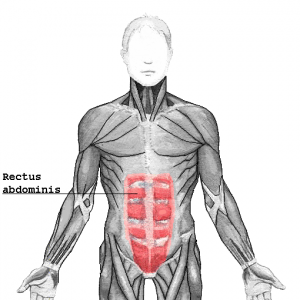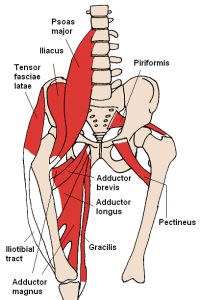
It’s often thought that a protruding belly posture is due to weak abdominals. In terms of fixing that faulty posture, it seems logical that if you were to “pull” the belly in by strengthening the abdominals, you would no longer have that protruding belly posture. That’s understandable, and may even be the case with a condition such as diastasis recti, but before we assume we’ve found the cause of the postural issue, let’s look at one alternative viewpoint.

It is tight psoas muscles, which lie behind the contents of the abdomen, that pull the spine forward and pull the pelvis into an anterior tilt (top of the pelvis rotates forward). They will also push the abdominal contents forward, creating the appearance of a protruded belly.
Have you ever noticed that your belly looks flatter in the morning (after you’ve been lying flat for 8 hours, your psoas muscles are more relaxed and lengthened) and looks more rounded or protruded later the day (after you’ve been sitting, driving, running, etc, your psoas muscles are chronically shortened and contracted). Of course there are confounding factors to this, timing of meals and digestion, etc. that can make a belly appear more or less rounded, but psoas muscle tightness is an important factor that contributes to a protruded belly posture. This is important not only for looks (not all of us want to constantly look like we’ve just eaten a big meal), but for function and comfort. Tight psoas muscles are a big contributor to low back pain, not to mention chronically tight psoas muscles can reciprocally inhibit the gluteal muscles, leaving us with dead butt syndrome.
So what should you do about tight psoas muscles? You could stretch them. And that will work great if this is a new tightness. But if the tightness has been going on for awhile, the muscle will have entered the cumulative injury cycle.
First line of defense is to try stretching your psoas muscles. Here’s how:
Stretch your hamstrings too, since tightness in the psoas and the hamstrings often occur together.
Any time a muscle is overworked (repetitive motions, repeated contractions) or acutely injured (fall or collision causing a tear or crush), it receives a decreased amount of bloodflow (read: oxygen flow). If this condition continues, the hypoxia (lack or oxygen flow) causes adhesions to form in the muscles. These are sticky areas, almost as if someone poured glue into the muscle, which limit range of motion, alter your biomechanics, and cause pain. Adhesions remain until they are treated. Rest, ice, stretching, and ibuprofen will not make them go away! It’s like trying to stretch a rope that has a knot in it. You might get a bit of stretch on either end, but the knot in the middle will just become tighter. You may get some temporary relief with rest, ice, or stretching, but once you resume your activities, the issue will make itself known once again.
So what will work to resolve the muscle tightness? Active Release Techniques (ART) is a great option. ART will increase circulation to the muscles, decrease inflammation, and restore functional motion to the hips. What this means, is that it will clear out adhesions through an entire range of movement. ART protocols will typically require the sports chiropractor to shorten the involved muscles (to shorten the psoas muscle you would bring the knee towards the chest), take a thumb or hand contact with a specific direction of tension, and then maintain that tension while the client lengthens out the muscle (bringing the leg behind you in hip extension). This breaks up the adhesions and allows for the restoration of full functional movement.
If you are suffering from low back pain, hip pain, or feeling like your belly is constantly being pulled forward, call us today to schedule an appointment to find out whether a tight psoas muscle is to blame. 510-465-2342.
Image credits: wiki commons
